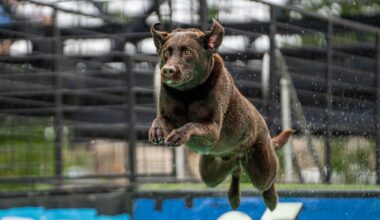Can Senior Dogs Learn New Tricks? Aging Myth Explained
When we think about aging, there are many preconceived notions that often take root in our minds. One of the most persistent myths is that senior dogs cannot learn new tricks or behaviors. This assumption can be harmful, as it undermines the capabilities of older dogs. The reality is that, although dogs may take a bit longer to learn at an older age, their brains remain adaptable and capable of learning. Older dogs possess wisdom and experience that can facilitate the learning process if approached correctly. Just like humans, they benefit from mental stimulation, which can be provided through learning new commands. Positive reinforcement techniques, such as treats and praise, can be especially effective. It is also essential to keep training sessions short and engaging to maintain their interest. With patients and consistency, many senior dogs can master new skills, creating not only a sense of accomplishment but also strengthening the bond between the dog and its owner.
The Benefits of Learning for Senior Dogs
Learning new tricks or commands can have numerous benefits for senior dogs beyond mere entertainment. Engaging their minds can help stave off cognitive decline. Mental exercises are crucial for maintaining cognitive health and can even delay the onset of cognitive dysfunction syndrome in dogs. Additionally, the physical activity involved during training can help to keep senior dogs more agile and active. Their bodies may be aging, but incorporating training into their daily routine can encourage movement and physical exercise. Furthermore, the act of learning and achieving new tricks can boost a senior dog’s confidence. When they successfully perform a command, it’s essential for their emotional well-being. A confident dog is generally a happier dog, which can lead to a better quality of life. Also, training provides a routine and structure that helps to create a sense of predictability, which is comforting for aging dogs. Owners often find that regular training can improve overall behavior, making living together more enjoyable for both parties.
Despite the many benefits of training, some owners may feel discouraged by their dog’s slower learning pace. It is essential to recognize that older dogs have different needs and capabilities than younger dogs. Their attention spans may be shorter, and they might need more breaks during training sessions. That’s perfectly normal; adapting training techniques to suit a senior dog’s individual pace can make a significant difference. It can also help to implement short training sessions throughout the day rather than one long session. This way, you can keep your dog engaged without overwhelming them. Use varied techniques to hold their interest, like incorporating toys or games into your training regime. Remember to keep things light-hearted and fun. When training feels enjoyable, the motivation to learn increases significantly. Dogs often pick up on their owner’s energy, so maintaining a positive attitude during training will motivate your senior dog to engage and learn. With the right approach, senior dogs can and will continue to learn new tricks.
Overcoming Challenges in Senior Dog Training
Training a senior dog comes with challenges that may not be present with younger canines. Physical limitations such as joint issues, arthritis, or reduced mobility can affect their ability to perform certain tricks. It’s vital to be mindful of these conditions and choose tricks that are suitable for their physical capabilities. Low-impact tricks such as sit, shake, or lie down may be more appropriate. In those instances, consult a veterinarian to understand your dog’s specific needs fully. Moreover, patience is crucial when training senior dogs, as they may have established habits over their life. Consistency in training and reinforcing positive behavior will help with transitioning unwanted behaviors. Break down commands into smaller, manageable steps to help them grasp new concepts more effectively. Timing is also essential; use treats or praises immediately after they perform the desired action to establish a clear connection. Each dog is unique, so finding the right balance in your approach can lead to successful learning outcomes. Senior dogs thrive on affection, making training an excellent opportunity for bonding.
Additionally, age-related health issues may also influence a senior dog’s learning ability. Hearing or vision impairments can be inherent in aging dogs, which can complicate traditional commands that rely on sight or sound. In such cases, tactile or visual cues, like hand signals or touch, can be incredibly effective. For example, using a gentle nudge with your hand can signal your dog to perform a trick rather than relying solely on verbal commands. Understanding these adaptations can contribute significantly to a successful training experience. Regular check-ups with the veterinarian can also help monitor any health conditions impacting your dog’s ability to learn and adapt. By identifying any issues early on, you can modify your training strategies to better suit their needs. Training can also serve as an excellent way to assess their health gradually and keep you informed about your dog’s wellbeing. Be observant; small changes in behavior can indicate underlying problems that need immediate attention. By staying proactive, you create a nurturing environment that encourages learning even into old age.
Integrating Learning into Daily Routines
Incorporating training into daily routines offers a practical and effective way to ensure that your senior dog continues to learn. For example, ask your senior dog to sit before being allowed to eat their meal, reinforcing the training of commands into everyday life. This integration encourages learning without needing dedicated training sessions and enhances your dog’s mental stimulation. Using common commands throughout their daily routine keeps their brains engaged while reinforcing obedience. During walks, practice commands like “heel” or “stay” using gentle leash guidance. Short bursts of training during playtime can also add variety and keep your senior dog’s interest piqued. Consider using interactive puzzle toys that encourage problem-solving while rewarding them with treats. Engaging their minds through toys designed for older dogs can stimulate cognitive function. This type of play helps to keep the excitement in their learning process. The key is to ensure that the activities remain enjoyable and stress-free. This positive environment can help your senior dog feel secure while allowing them to absorb new information. By making learning enjoyable, you open the door to new skills.
To conclude, the perception that senior dogs cannot learn new tricks is a myth that can be debunked. With the right approach, patience, and understanding, your older dog can flourish and learn new skills, enhancing their life in meaningful ways. Remember, the goal of training isn’t just about teaching them commands; it’s about creating a stronger bond between you and your dog. Focus on encouraging your senior dog, acknowledging their progress, and celebrating small victories. Each command learned paves the way towards increased confidence and a new sense of purpose. Make sure that your experiences together are enjoyable and filled with love; positive associations will encourage further learning. Besides, an engaged and mentally stimulated dog is a happy one. Ultimately, aging is a natural process, and dogs, like humans, can thrive during this phase of life. Whether you’re teaching a fun trick or diving into practical command training, the connection you build through this process will create lasting memories. Your efforts will not go unappreciated by your senior companion, allowing their golden years to shine even brighter.
“If you want to integrate learning into your senior dog’s life, don’t forget to incorporate plenty of love and patience. Your care makes all the difference in their willingness to learn and thrive, regardless of age!”


